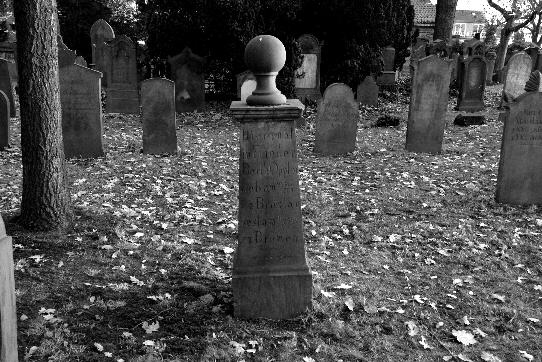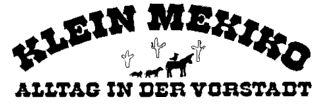|
|
|

|
A look at the old Jewish cemetery in Bremen, especially at the area, where the most of those tombstones are, which date back to the 19th century.
|
|
In the foreground you see the tomb of Berth(hold?) Oppler from the year 1850.
|
I once more stayed at the nearby Jewish cemetery for several hours. I spent that time staying at that area of the graveyard, where the most of those tombstones are, which date back to the end of the 18th century, the 19th century and the early 20th century.
The tombstone of Berth(old?) Oppler deeply impressed me. The small inscription 'dedicated by his friends' at the bottom of the stone puts him into the midst of his mourning friends. According to the inscription, Oppler was born in Wroclaw, March 24th 1769, and died in Bremen, August 10th 1850. The year dates of the inscription involuntarily evoke historico-cultural backgrounds in me. Mozart was 13 years old in Oppler's year of birth and Goethe was dead already 18 years in his year of death. The failed bourgeois- democratic revolution of 1848, which had pursued a nation-state building policy, dated back more than two years.
One doesn't know, how much those incidents affected Oppler. But we know that he had friends who dedicated a memorial to him. The memorial which has a sphere at the top, has a design which is a little bit more elaborate than most of the gravestones of that period which, in their austerity, remind me of a symbol of a house. The practice of multiple burials in a family grave with one tombstone wasn't common at that time. And so each house/ tombstone represents a person.
Besides a tombstone with the inscription ' Here lies/ Joseph Wolff/ from Dannenberg/ born, November 11th 1788/ died July 15th 1856' there is for example an other tombstone 'Here lies in God/ Rahel Wolff / from Dannenberg/ born, July 9th 1799/ died, November 20th 1860'.
This way every jew moved to this imagined city of dead people over the years of that century. In this city of dead people one learns something not only about the congregational life of the Jewish community in Bremen, but also about the daily life of the people in those times. 'Damsel Jeanette Meyer, obiit December 3rd 1872' has a house in the city of death people.
|
|
The inscription says nothing about her date of birth and hence about her age, but it says something however about her civil status. One is nowadays not allowed to label such a civil status this way neither in social contact nor on a tomstone. Nowadays it's also unacceptable to bury a woman with the following inscription 'Mrs Elias Spanier/ Sara née Löwenberg/ born December 10th 1817/ died February 9th 1908'.
Tombstones for at least two foreign jews, who had died during the considered period, were erected and have inscriptions in the native language of the deads. The probably oldest preserved tombstone, which is located close to the today's entrance of the grave yard, is erected as a memento of 'Lewis Simeon of London/ Obiit/ 29. November 1796/ Aged 32 YeArs'. By means of his tombstone you learn more details about the life of 'Théophile Kahn/ né à Waltenheim/ Baße Alsace/ décédé à Rockwinkel/ près Brême/ le 26. Novembre 1872/ après un longue et/ douloureuse maladie/ Que son âme repose/ en paix!' (Théophile Kahn/ born in Waltenheim/ Lower Alsace / died in Rockwinkel/ near Bremen/ November 26th 1872/ after a long and/ painfull illness / May his soul rest/ in peace!')
Exceptionally many children died as measured by today's standards A slab, which was set into a stone, tells us of the grief of the Koopmann family 'Here lies our dearly-loved/ son/ Robert Koopmann/ born, July 14th 1882/ died, June 15th 1891'. There are also several graves of children who died in babyhood or in toddler age. Thera are very little tombstones, which only have a number instead of an inscription, near to the grave stone of Lewis Simeon, but also here and there in the considered area of the grave yard. Those small tombstones are graves of children who died very young. (cf. concerning this - Anne E. Dünzelmann: Juden in Hastedt, Bremen 1995, p. 153 et seq., only available in German).
|
Please also read
- Charlie Dittmeier's report on burial ritual in Hong Kong The report is dated June 20 1998. The link leads to the latest entry of the diary. Please scroll down..
- A look at the old Jewish cemetery in Bremen
- Rebecca Lesses' report about Headstones in Liepaja Jewish Cemetery in Latvia.
|
|
Next issue 'The Daily Groove'
Thursday, December 23 2010.
I am occupied with printing and distributing the new booklet. It's a very arduous job. Please bear with me.
< previous issue next issue >
We would like to point out that we translated articles from German into English for the purpose of service. We would like to make it clear that the German translations are deciding, because the articles are directed to users who live in Germany.
Wir möchten darauf hinweisen, dass wir zu Servicezwecken englische Übersetzungen vorgenommen haben. Klarstellen möchten wir, dass maßgeblich die deutsche Übersetzung ist. Grund dessen ist, dass wir uns an in Deutschland ansässige Nutzer wenden.
Please also read Cats Talk (48)
|
|
|
|
|
place marker for advertisement

|
|


